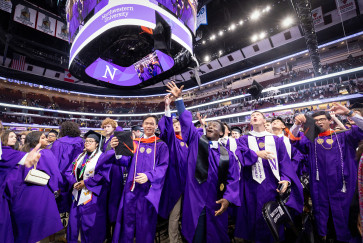This article originally appeared in Medium on January 25, 2016.
By Jillana Enteen
In just a few years, Snapchat has come a very long way from a forbidden teen selfie to the State of The Union. The application with the fitting icon of a ghost (images disappear after 24 hours) has moved into firmly into politics and is expanding its user base and functions. Unofficial news this week is that Snapchat is changing some of its chat features and screen design. Some outlets report that Snapchat is aiming to attract more users older than 35.
While President Barack Obama joined Twitter in 2013 @POTUS and has more than 6 million followers, in the days before his recent final State of the Union address, the White House blog announced, “We’re on Snapchat: Add White House.” Morphing from the social networking app where U.S. teens were known for sexting, it’s now the unofficial application for timeless records of presidential decrees.
Whether that remains the case after a new president arrives in the Oval Office in 2017 is debatable. Both Hillary Clinton and Donald Trump use Snapchat on the campaign trail, as does Bernie Sanders — even if he called it Snapshot. Snapchat Stories has a 2016 campaign feature that launches in Iowa next week.
Who Are Snapchatters and Why Do Pols Care?
Overall, social media is certainly influencing how adults ages 18–34 years old gather political information and form their opinions based on sites such as Facebook and Twitter. A new study from researchers at the University of Hawaii shows that what appears on someone’s personal newsfeed is as influential as what may be breaking news on vetted media sites.
In a recent Popsugar poll, close to 50 percent of women surveyed said social media was a top source for political news.
The problem then with all users becomes one of trustworthiness and accountability. It is about not only about the broadened application of Snapchat, but whether we can trust who is using Snapchat to distribute information and if that information is correct.
Joshua Miller, director of product management at the White House wrote on the White House Official Blog, “…the White House is joining Snapchat to engage this broad cross-section of the population in new and creative ways.”
The Evolution of Snapchat
The company behind Snapchat has gone from promoting the erasure feature to its expanded status including one as a media repository in the global reporting business. Media companies such as NPR and CNN use Snapchat to cover breaking news, such as the San Bernardino shootings last month.
This is a remarkable shift in mission. Snapchat started in 2011 as Picaboo, an ephemeral way to send sexy pictures to others. Renamed Snapchat in 2012, it was still committed to being ephemeral — a place where a user could be spontaneous because in 24 hours, the message would be deleted.
In 2013, the company launched Stories, which allowed a feature of not just deleting or disappearing, but for saving snaps to the user’s cameraroll. Then, Almost exactly one year ago, Snapchat launched Discover, a distribution platform, the likes of youtube. A company ad recently effused: “Nearly 100 million Snapchatters use the app every day — and they are super engaged. Over 60% of people who use Snachat daily create content every day!”
To put that in perspective, the entire Philippine population is 100 million.
More specifically, Snapchat claims to be “the best way to reach 13–34 year olds,” citing sources such as the U.S. Census Bureau, ComScore MobiLens 2015 and Snapchat internal data.
And these users are not just sexting anymore, according to a new University of Washington study.
Yes, the Snapchat demographics are younger than users of other popular apps. They report that 23 percent of users are 13–17 year olds — who are not of voting age. A greater percentage or 37 percent, are between the ages of 18 and 24. More than a quarter, or 26 percent are 24–34 year-olds. And these are voters.
These stats fail, however, to define users by race, voting preferences, or other identifiers that may be ultimately useful on the presidential race. Still, the political strategy may be to cast a wide as net as possible and hope to pull in some fish.
Here Now and Gone, in a Snap
Regardless of who is receiving the content and how, in this heated campaign season, messages must bear credibility. Citizens need to trust verified content and also need to know what applications and accounts on those social media tools to trust. This informs voting.
Even world leaders are confused by the verity of online sources. Recently, former Swedish Prime Minister Carl Bildt tweeted fake transcripts of conversations between Bill Clinton and Tony Blair. Rather than consulting the recently released originals, he quoted a spoof Tumblr post by comedian Michael Spicer. Bildt was lost between Tumblr and the originals, released by the Clinton Digital Library.
False accounts attributed to politicians and celebrities are nothing new. Trump has been accused of voting for Obama based on a fake tweet. Chicago Mayor Rahm Emanuel didn’t even know the source of his fake tweets shortly after his victory in the 2011 mayoral election.
To be sure, verification and fact checking sites such as Politifact, Factcheck, Google and and Snopes exist to blunt false information from spreading.
As an individual consumer, verification software such as Verified Pixel, SAM(Social Asset Management) can fill the need to check for credible social media content.
Attracting Young Voters Not New
Rock the Vote was founded in 1990 to engage younger voters in the political process. It is now a social media movement to get 18 year olds to vote, engaging those younger voters on Twitter, Tumblr, Flickr, Youtube and Facebook. But not Snapchat.
Still, Snapchat is the forum for another site aimed at young voters, Do Something.org.
On the company’s first birthday, co-founder Evan Spiegel who created Snapchat as a class project at Stanford University, wrote on his blog post, “It’s about communicating with the full range of human emotion — not just what appears to be pretty or perfect.”
So far the run for the presidency has been neither pretty nor perfect. And whether or not social media and Snapchat users — who number 100 million, or the equivalent of the entire Philippine population — will determine who is the next leader of the free world is not yet clear. But it is unlikely its enormous influence will disappear as quickly as its stories.
- Jillana Enteen is an Assistant Professor of Gender and Sexuality Studies and Digital Humanities at Northwestern University and author of Import/Export: Thai English as Transnational Studies. She is a fellow of the Northwestern University Public Voices Fellowship through The OpEd Project.

